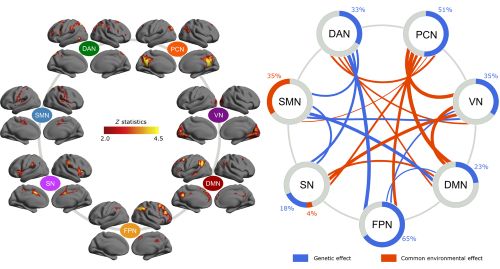Genetic and environmental contributions to functional connectivity architecture of the human brain
Published in Cerebral Cortex, 2016
Recommended citation: Zhi, Yang; Xi-Nian, Zuo; Katie L, McMahon; R Cameron, Craddock; Clare, Kelly; Greig I, de Zubicaray; Ian, Hickie; Peter A, Bandettini; F Xavier, Castellanos; Michael P, Milham; Margaret J, Wright. (2016). "Genetic and environmental contributions to functional connectivity architecture of the human brain." Cerebral Cortex, 26(5):2341-2352. https://academic.oup.com/cercor/article/26/5/2341/1754303
One of the grand challenges faced by neuroscience is to delineate the determinants of interindividual variation in the comprehensive structural and functional connection matrices that comprise the human connectome. At present, this endeavor appears most tractable at the macroanatomic scale, where intrinsic brain activity exhibits robust patterns of synchrony that recapitulate core functional circuits at the individual level. Here, we use a classical twin study design to examine the heritability of intrinsic functional network properties in 101 twin pairs, including network activity and internetwork coherence. Our results suggest that the source of interindividual variation in functional connectome has a modular architecture: individual modules represented by intrinsic connectivity networks are genetic controlled, while environmental factors influence the interplays between the modules. This work further provides network-specific hypotheses for discovery of the specific genetic and environmental factors influencing functional specialization and integration of the human brain.

Read this paper via the Open Access at Oxford Press
Recommended citation: Zhi, Yang; Xi-Nian, Zuo; Katie L, McMahon; R Cameron, Craddock; Clare, Kelly; Greig I, de Zubicaray; Ian, Hickie; Peter A, Bandettini; F Xavier, Castellanos; Michael P, Milham; Margaret J, Wright. (2016). Genetic and environmental contributions to functional connectivity architecture of the human brain. Cerebral Cortex, 26(5):2341-2352.
